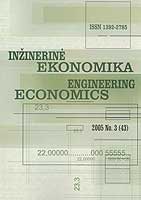The Study of the Assumptions of Development Quality and Product’s Safety Integrated System
The Study of the Assumptions of Development Quality and Product’s Safety Integrated System
Author(s): Aldona Čepulis, Juozas RuževičiusSubject(s): Economy
Published by: Kauno Technologijos Universitetas
Keywords: quality management; safety management; HACCP; ISO 9001; ISO 22000.
Summary/Abstract: The main purpose of this work is to analyze the food quality regulation system and food safety assurance. This article also highlights the conditions, which must be met for an integrated quality and food safety management system to be implemented at the AB “Vilniaus Pergalė” confectionery plant. This article also examines various international systems of regulating trade and quality. It gives an analysis of the processes in place designed to normalise international standards, technical regulations and rules in the light of current global economic conditions. With the increasing complexity of the composition and technologies associated with the production of certain food products, the cost of maintaining State inspection services has become an unacceptable financial burden. Governments have started to look for the ways to reduce the financial costs associated with food control without reducing its effectiveness. This changed the definition of inspection in the food industry by returning the responsibility for food quality control and safety to the producer and distributor. Implementing of food safety assurance system – Hazard Analysis Critical Control Points (HACCP) was started. When comparing the current HACCP system with ISO 22000, certain new requirements can be seen, such as the creation of interactive communication systems within and outside the company, the creation of a system for the prevention of unforeseen situations, implementation of certain necessary programs, etc. The analysis showed that both standards are compatible and ISO 22000 requirements can be easily integrated with other food safety assurance subsystems. An effective communication management system must be created between the producer, suppliers, subcontractors and consumers (first concerning information about the product), government institutions overseeing the food products market or other organizations, which will affect or be affected by the results of the food safety management system. The integrated safety and quality system is being developed and implemented at AB “Vilniaus Pergalė”. This system will include an interactive communications system, procedures to prevent unforeseen events, product labeling procedures, other subsystems and other required programs, which will assure product safety and improve the overall quality at the company.
Journal: Engineering Economics
- Issue Year: 2006
- Issue No: 1 (46)
- Page Range: 69-73
- Page Count: 5
- Language: English

